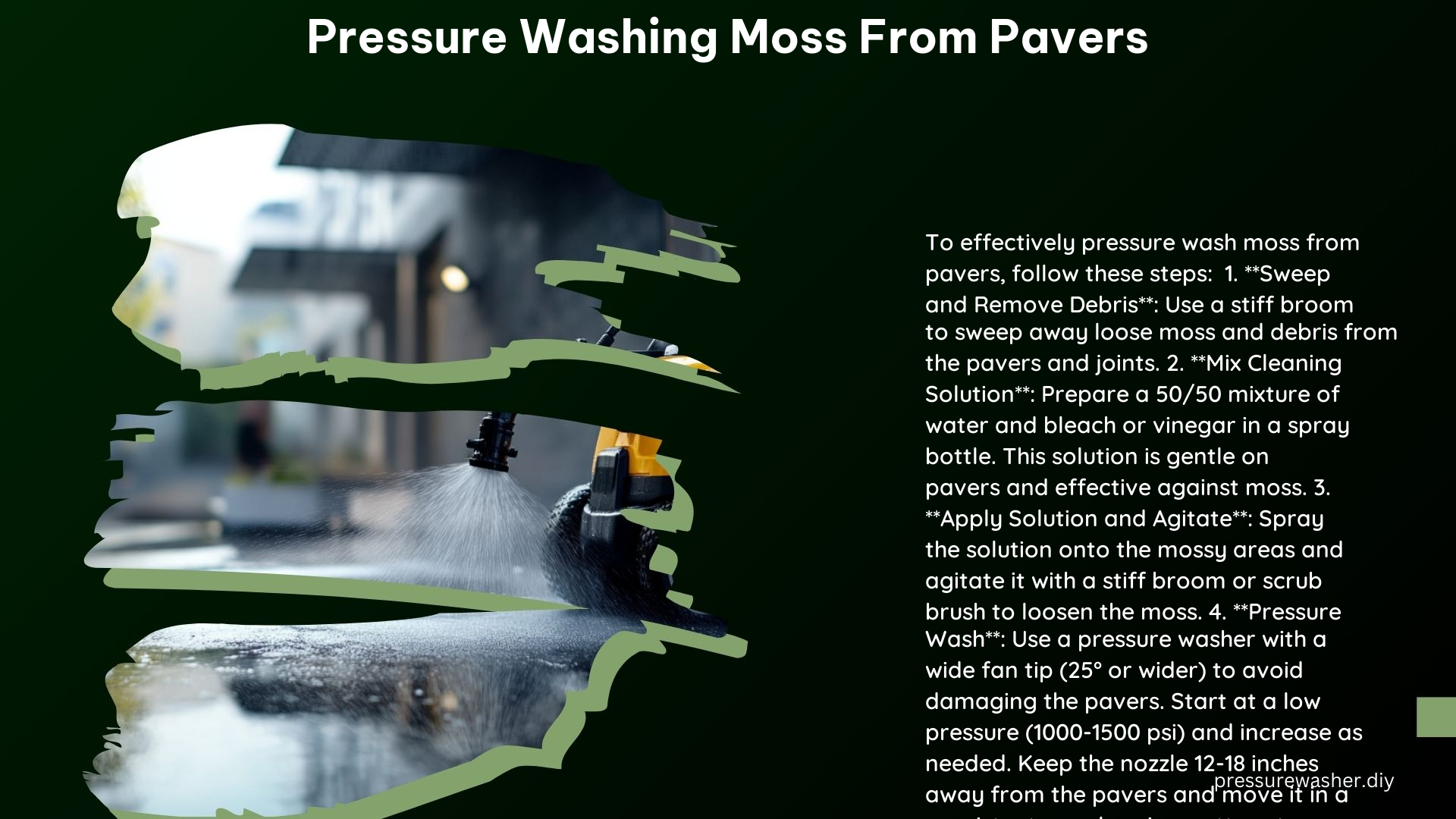Maintaining the cleanliness and appearance of your paved outdoor spaces is crucial for both aesthetic and safety reasons. One common issue that homeowners face is the growth of moss on their pavers, which can make the surface slippery and unsightly. Pressure washing is an effective solution to remove moss from pavers, but it requires careful consideration to avoid damaging the pavers. This comprehensive guide will provide you with the technical details and best practices for pressure washing moss from pavers.
Recommended Pressure Setting
The recommended pressure setting for effectively removing moss from pavers is typically between 1,500 and 2,000 pounds per square inch (psi). This range of pressure is effective in dislodging and removing moss without causing significant damage to the pavers. For example, a Ryobi 2000 psi pressure washer has been successfully used in various videos to clean patio pavers with moss growth.
It’s important to note that the specific pressure setting may vary depending on the type and condition of your pavers. Softer or more delicate pavers may require a lower pressure setting to prevent cracking or chipping. Always start with the lowest pressure setting and gradually increase it until you achieve the desired cleaning result.
Frequency of Pressure Washing

To prevent the recurrence of moss growth on your pavers, it is recommended to pressure wash the area several times throughout the season. The frequency of pressure washing will depend on factors such as the climate, the amount of shade, and the rate of moss growth in your specific location.
As a general guideline, it’s recommended to pressure wash your pavers at least twice a year, typically in the spring and fall. This frequency helps maintain a clean and dry surface, making it less conducive to moss growth. In areas with heavy moss growth or high humidity, you may need to pressure wash more frequently, such as every few months.
Precautions to Avoid Damaging Pavers
While pressure washing is an effective method for removing moss from pavers, it’s crucial to take the necessary precautions to avoid damaging the pavers. Here are the key steps to follow:
-
Use the Correct Pressure Setting: As mentioned earlier, avoid using too high a pressure, as it can damage the pavers or dislodge the joint sand. Start with the lowest pressure setting and gradually increase it until you achieve the desired cleaning result.
-
Use a Wide Fan Tip: A wide fan tip nozzle helps distribute the pressure more evenly across the surface, reducing the risk of localized damage to the pavers.
-
Maintain a Safe Distance: Keep the pressure washer nozzle at a safe distance from the pavers, typically around 6-12 inches, to prevent damage from the high-pressure stream.
-
Utilize a Cleaning Solution: Mixing a 10-15% solution of bleach and water can help kill moss and algae without damaging the pavers. Alternatively, a 50/50 mixture of water and bleach or vinegar can also be effective.
-
Avoid High-Pressure Nozzles: Turbo cleaning nozzles or other high-pressure attachments can be too aggressive and may cause damage to the pavers or the joint sand.
-
Test a Small Area First: Before pressure washing the entire area, test the pressure setting and cleaning solution on a small, inconspicuous section of the pavers to ensure they won’t cause any damage.
Technical Specifications
To effectively pressure wash moss from pavers, consider the following technical specifications:
-
Pressure Washer: A pressure washer with a minimum of 1,500 psi is recommended for effective moss removal. Higher-powered models, such as a 2,000 psi pressure washer, can provide even better results.
-
Cleaning Solution: A 10-15% solution of bleach and water or a 50/50 mixture of water and bleach/vinegar can be used to kill moss and algae without causing significant damage to the pavers.
-
Nozzle Type: A wide fan tip nozzle, typically with a 25-40 degree spray angle, is recommended for even pressure distribution and to minimize the risk of damage to the pavers.
Additional Tips
To further enhance the effectiveness and safety of pressure washing moss from pavers, consider the following additional tips:
-
Sweep the Area Before Pressure Washing: Remove any loose debris, such as leaves or twigs, to ensure the pressure washer can effectively clean the pavers.
-
Use a Stiff Broom or Scrub Brush: These tools can help dislodge and remove moss and debris from tight corners and between the pavers, where the pressure washer may not reach effectively.
-
Rinse the Area Thoroughly: After pressure washing, rinse the area with fresh water to remove any remaining cleaning solution and debris, ensuring a clean and safe surface.
By following these technical guidelines and best practices, you can effectively pressure wash moss from your pavers while minimizing the risk of damage to the surface.
References
- YouTube Video: How To Clean Your Patio and Kill Moss
- YouTube Video: HOW TO PRESSURE WASH YOUR PATIO AND GET RID OF MOSS
- The Paver Savers: How Do I Get Rid of Moss on My Pavers?
- Reddit: We love the moss, but is there a safe way to clean the pavers without disturbing it?
- Judge Mobile Wash: How to Remove Moss From Pavers
